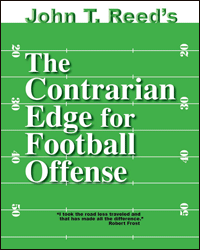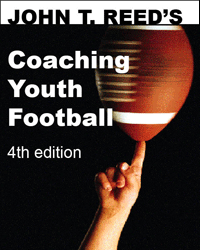2015 Army-Navy Game
Posted by John Reed on
Tomorrow is the Army-Navy Game. West Point grads often end correspondence to other West Point grads with the words “Beat Navy.” I don’t. I’m a writer. We do not use cliches of that nature. Navy grads do the same only “Beat Army.” Some Navy grads end correspondence to me that way.
I refused to bet with Ross Perot on the Army-Navy Game
In 1977, I had dinner with Ross Perot who was the Bill Gates of the time. He is an Annapolis grad. He tried to get me to bet with him on the Army-Navy game. I declined explaining that my heart would be with Army because I graduated from there, but being a Harvard MBA student at the time, I knew too much about probability and decision theory to take the bet. Army lost that year.
Since then, I got involved with football coaching as a result of my kids playing the sport and wrote 8 books on football coaching as well as many magazine and web articles. Here are three of them.



My wife and I will be watching the game tomorrow with three of my classmates and their wives. Who’s going to win? Navy. They are ranked 21st; Army is just rank. A state boxing commission would not allow the fight to take place.
May win with a contrarian approach
Will I eat crow if Army wins? I have urged Army to take a whole different approach to offense—radical—in order to have a chance to win. If they do and win, I will say, “told ya.” If they play them straight up using the offense they have been using all season—and win—I will call for a toxicology report on Navy’s pre-game meal.
What you knew at the time, not results
Also, I would note that evaluation of decisions or in this case, a prediction, should not be based on results, but rather on what the decision maker or predictor knew at the time he made the prediction. Anyone who predicts an Army win in advance of this game must be part of the conspiracy to throw a grenade in the Navy locker room at half time.
Golden era in some ways was when my classmates and I were cadets
When I was a cadet in the 1960s, the Army-Navy Game set attendances records averaging over 100,000 each year that decade. It never did before that decade or since.
Army won my freshman year, defeating defending Heisman Trophy winner and future NFL star Roger Staubach (and his center, the “32 years like myself” New Day mortgage company CEO who is incessantly on TV nowadays). We won another game, lost one, and tied one the rest of my time there. We were ranked 20th in the nation one week when I was a cadet. Our coach was the NCAA major college Coach of the Year one year.
Recuse myself?
Will I cheer for Army tomorrow. Maybe it might slip through because of ingrained cadet habit, but I probably should recuse myself because of all my years of studying football coaching. Army is a very bad football program. Since they fired Bob Sutton after the 1999 season, Army has gone 44-133. The Army-Navy Game record is 1-14 with the win being in 2001.
Army football player boots on the ground
Why? Ask what was constant over those years. The answer is boots on the ground in Iraq and Afghanistan for almost all those years. At Army, being one of them after graduation is mandatory. At Navy, you can pick marines or SEALs, but you don’t have to. Air Force has no boots.
Another constant is the West Point chain of command which is a handful of lifer temps in the job of superintendent leaving every three years or so. That has always been the case at Army, but seems to have become fatal since the 1990s. I do not know the system at Navy or Air Force. I also surmise there is some resistance at the Pentagon or White House which may affect Army more than Navy and Air Force.
But fundamentally, there is no excuse for any Division I-A football program going 44-133 over a 16-year period. If they want to win, they have to keep changing the key people until they start winning. They have changed coaches 6 times during those 16 years. So it’s apparently not the coach, or only the coach, who is the key to all the losing.
An insider told me the players are performing at about the level the recruiting analysts predict. In other words, when they look at the high school seniors Army got in year A, they predict where Army will finish four years later, and they are right. That means they cannot recruit as well as competitors. Also that they are unable to add value with their scheme or other coaching skills.
If they cannot fix the front office enough to attract a good coach who, in turn , can attract better players, they should leave D-I and stop making fools of themselves.
The West Point ‘brand’
They are big on talking about their “brand” these days. To a very large extent, they have destroyed their brand via their embarrassing football program. I don’t know enough about the behind-the-scenes machinations to do a precise diagnosis, but I can see 44-133 and 1-16 in the arch-rival game. That is a fundamentally incompetent football program apparently caused by incompetence ABOVE the level of the head coach, manifest in part by inability to hire a competent coach.
Here is a reader comment and my response:
I did go on alert about his reason for getting out of the Army. He wanted to be a platoon leader forever and the Army only lets you do that for a year or two. When I was in, I heard the best job in the Army was company commander. I was not a fan of the Army then and scoffed that the Army HAD any good jobs.
Then I became “the old man”—a company commander—at age 24. To my surprise, I really enjoyed that, and it was just an AIT company not a line company—400 guys which is battalion size—but still I was like a hotel/restaurant manager and it was still one of the most fun jobs I ever had.
For all the talk about leading men at West Point, the actual careers of my classmates who stayed in were typically a year or so of platoon leader, six months or so of company commander—and that was it. Most never became battalion commanders. So the 20-25 years of career had maybe two or three years of commanding a unit, and probably two or three different units for less than a year each. More what Major League baseball players call a “cup of coffee” when they get called up briefly in September. In my case, I had 5 years of leadership training to do what turned out to be a total of eleven months of command in three different units at three different bases.
The only guys who got to do fun stuff their whole careers seemed to be warrant officers and doctors. The rest of us were warm-body, utility-infielder jacks of all trades—eternal temps in olive drab.
http://www.nfl.com/photoessays/0ap3000000493195
But the Army winning percentage since they fired Bob Sutton is 44 ÷ 177 = .249.—worse than the worst all-time college record in history! Army also holds the record for the worst ever season—most losses in one season—0-13 in 2003. Still unbroken.
It’s worse than people realize
Army, at the moment, is ranked 122 out of 128.
501(c)(3)
The last coach to be fired at West Point—Ellerson—was the 106th highest paid coach of the then 126 coaches in D-I NCAA football. Hmmmm. I think that also is about where his Army teams were ranked when he was there. You bring in a recruiting class that ranks 106th highest, you pay your coach 106th highest, and you are surprised when your team is ranked 106th? Why?
Not enough option football players
Now I’m gonna get crap for making excuses. West Pointers don’t do that.
But since graduation, I figured out that fixing a problem requires first diagnosing it. “No excuse” does not advance that ball.
No one is in charge of fixing Army football long-term; and that’s exactly who is fixing it: no one
Here is my post-game, post-Heisman update:
For students of the game and students of probability and statistics and decision theory: Either Army rose up dramatically or Navy played poorly for them. Army coach incompetence confirmed by such things as four fumbled center-QB exchanges—one lost to Navy. After the final such fumble, the one that Navy recovered, Coach Monken was seen showing the Army QB to hold the heels of his hands together when receiving the snap. Have I ever done that? Many times—to NINE-YEAR-OLD BOYS and 14-YEAR-OLD-HIGH-SCHOOL FRESHMEN in the first week of PRESEASON!
1,200 hundred snaps before the first game
 quarterback-center snap (Each QB-C pair must get 1,200 reps before the first game. This is a two-player-only activity. Snapping to a coach or non-QB is a waste of time and probably harmful. Each QB and C must learn to work together. Since you must have three strings of centers and quarterbacks, each needs 3,600 reps total.)
quarterback-center snap (Each QB-C pair must get 1,200 reps before the first game. This is a two-player-only activity. Snapping to a coach or non-QB is a waste of time and probably harmful. Each QB and C must learn to work together. Since you must have three strings of centers and quarterbacks, each needs 3,600 reps total.)I mean that 1,200 reps per C-QB pair literally. And you have to continue after the season starts to get a ton of C-QB pair reps daily. Our first ten or fifteen minutes every day had the C-QB pairs snapping and rotating so each QB got equal reps with each C.
Am I saying Coach Monken needs to read my Coaching Youth Football book? Apparently. Actually that 1,200 reps things is in all my books that discuss offense. Will he be pissed if he learns I said he should read that book? Probably. But if there’s any chance he does not already know it, the Long Gray Line is really pissed about the Army record since 2000. We are beyond worrying about the feelings of the latest loser coach.
Did my 1,200 reps rule work? Check out the May 1994 edition of Sports Illustrated For Kids. It featured a two-page spread on my long snapper Richard Chinn who snapped 402 long snaps without error. His streak only ended because the season ended. (We ran the single wing offense so all our snaps were long snaps.)
In 1996 when I was freshman offensive coordinator at Granada High School, I believe the only fumbled snap was one in the last game in the rain. Shame on me for not making sure we took a lot of snaps with a wet ball. Actually I may have done the wet ball in practice that season, too. I always have toward the end of my coaching career. But we only had that one fumbled snap that season—with a QB who had never played football previously. (I instantly yanked that QB out of the game and he stayed on the bench the rest of the game.)
In 2004 at the Monte Vista High School freshman team, I noticed that the QB was sometimes rotating the ball during his three-step drop to get the laces where he wanted them. It seemed like that fiddling was causing the passes to be inaccurate on those plays, I chewed out both the QB and C. “You guys will get that ball into the QB’s hand with the laces in the exact right place the moment it hits his hand every time. I do NOT want the QB finding those laces during his drop!” They fixed it and the subsequent passes were accurate. I was long past worrying about fumbled snaps. I was worrying about the laces being an inch or two out of place. That is how delicate this process is—on a 14-year-old team—in preseason!
And remember Monken had FOUR fumbled snaps in the freaking ARMY-NAVY GAME, which is at the end of the season! Fumbled snaps are caused by coaching malpractice. It’s not the player’s fault, and as I stated above about Granada, if one of my QBs fumbled a snap, he was no longer in the game. So even when it might be the player’s fault, it becomes the coach’s fault if he leaves that player in the game, as Monken did.
The oomph principle
You may wonder where I got that “magic ” number of 1,200. By guessing the right number was 400, then getting my ass kicked because of bad snaps. Then I thought it might be 600. Nope. Then I tried 1,000. Still not it. Then I tried 1,200. Bingo! Been doing that ever since. I am confident that is the correct number.
The oomph principle comes up in many of my how-to books. I have a whole chapter about it in my Succeeding book. Malcolm Gladwell’s 10,000-hours rule in his book Outliers is a similar idea.
 For example, in baseball coaching, it takes two-thirds of the season to get two things right; sliding technique and throwing the ball from catcher to second base to stop a steal. It doesn’t take me or my readers that long because we do the necessary oomph in the pre-season. You need to get the players as many reps in pre-season as the average coach gives in two-thirds of the season.
For example, in baseball coaching, it takes two-thirds of the season to get two things right; sliding technique and throwing the ball from catcher to second base to stop a steal. It doesn’t take me or my readers that long because we do the necessary oomph in the pre-season. You need to get the players as many reps in pre-season as the average coach gives in two-thirds of the season.In researching the book, I asked hundreds of successful investors how they did what they did. There are about 180 actual case histories in the book. The answer I got from those who actually do foreclosures and probates and other techniques profitably, as opposed to those who tried and failed, is 50 to 1,000.

Little effort to block punts
Should have gone for it, not attempted a field goal, late in the game
23-point favorites
Ought to be able to stop the one star on a one-man team
Not enough reps of halfback pass
My son Dan was an Ivy League tailback. He threw that pass twice his senior year, both incomplete. How many reps did he get in practice the whole season of that play? Two, same as the number of game passes he threw. In one of his incompletions, it looked to me that the receiver did not run the route but rather gave up because it was not the regular QB throwing it. The pass was where it should be. The receiver was not. The other one should not have been thrown—two bad guys at ground zero. Not enough reps.
The final play Hail Mary pass by Army was successful, except no one showed any interest in catching the ball
Army beat the hell out of the point spread in spite of the above mentioned screw-ups, but they might have won the game if they had just played the ball rather than getting all jam-packed with the defenders on the last play of the game!? Army lost 21-17. Their post-Bob Sutton record is now 44-134, for a winning percentage of 44÷ 178 = .247.
Heart breaking.
Share this post
0 comment






